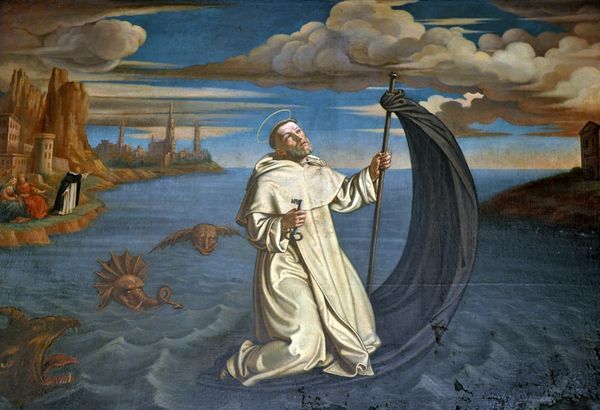Raymond of Penyafort was born in Vilafranca del Penedès, a small town near Barcelona, Principality of Catalonia, around 1175. Descended from a noble family with ties to the royal house of Aragon, he was educated in Barcelona and at the University of Bologna, where he received doctorates in both civil and canon law. From 1195 to 1210, he taught canon law. In 1210, he moved to Bologna, where he remained until 1222, including three years occupying the Chair of canon law at the university. He came to know the newly founded Dominican Order there. Raymond was attracted to the Dominican Order by the preaching of Blessed Reginald, prior of the Dominicans of Bologna, and received the habit at the age of 47, in the Dominican Convent of Barcelona, to which he had returned from Italy in 1222.
Raymond was instrumental in the founding of the Mercedarian friars. When approached by Peter Nolasco, Raymond encouraged and assisted him in obtaining the consent of King James I of Aragon for the foundation of the Order.
The need to study oriental languages was affirmed by the General Chapter of the Dominican Order in Paris in 1236. Raymond established the first school of the Studia Linguarum in Tunis, where it was known as the Studium arabicum. The objective of the schools was to help the Dominicans liberate Christian captives in Islamic lands.
Canon Law
Knowing Raymond's reputation in the juridical sciences, Gregory IX asked him to help in the rearranging and codifying of canon law. Canon laws, which were previously found scattered in many publications, were to be organized into one set of documents.
Papal decretal letters had been changing the law over the course of the previous 100 years since the publication of the Decretum of Gratian. Being pleased with Raymond's efforts, the pope announced the new publication in a Bull directed to the doctors and students of Paris and Bologna in September 1234, commanding that the work of Raymond alone should be considered authoritative, and should alone be used in the schools. His collection of canon law, known as the Decretals of Gregory IX, became a standard for almost 700 years. Canon law was finally fully codified by 1917.
The Miracle That Depicts St. Raymond
Raymond of Penyafort served as the confessor for King James I of Aragon. While on the island of Majorca to initiate a campaign to help convert the Moors living there, the king brought his mistress with him. Raymond reproved the king and asked him repeatedly to dismiss his concubine. The king refused to do so. Finally, the saint told the king that he could remain with him no longer and made plans to leave for Barcelona. But the king forbade Raymond to leave the island, and threatened punishment to any ship captain who dared to take him.
Raymond and his Dominican companion went down to the seashore where Raymond took off his cappa (the long black cloak worn by Dominicans over the white tunic and scapular), and spread one end of it on the water while rigging the other end to his walking staff. Having thus formed a miniature mast, Raymond bid the other Dominican to hop on, but his companion, lacking the saint’s faith, refused to do so. Then Raymond bid him farewell, and with the sign of the cross he pushed away from the shore and sailed away on his cloak. Skirting around the very boats that had forbidden him passage, the saint was seen by scores of sailors who shouted in astonishment and urged him on. Raymond sailed the 160 miles to Barcelona in the space of six hours, where his landing was witnessed by a crowd of amazed spectators. In awe of this miracle, King James I mended his ways.
I am still searching the collection for the relic that matches the document from 1950 shown below with many Ancient Saints*

Credits:
Discriptions of saints lives and biographies have been excerpted, summarized, or compiled from
Franciscan Media,
CatholicSaints.Info,
Catholic Online, and
Wikipedia.
